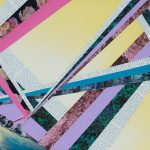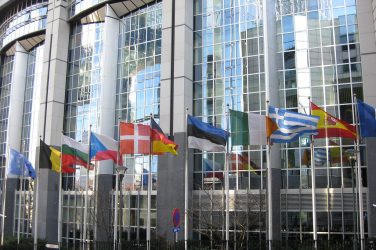Whether you are a huge history fan or completely indifferent, La Boite à Histoire should raise your curiosity as one great example of successful grassroots projects in Europe. E&M editor Victoria Jordan met with Daphné Budasz, one of the founders of La Boîte à Histoire – a project of public history consulting.
Daphné and her colleagues have the ambition of making history more exciting and accessible to wider publics, to become a field of collaboration from diverse sectors.
E&M: Hi Daphné! Thanks for taking the time to speak with E&M about your fantastic project! To begin with, can you tell me a bit about yourself?
Daphné: Thanks Victoria for organising this interview. I am the co-founder of La Boîte à Histoire. I grew up in Geneva, Switzerland but I have been living abroad for the last past years. I studied history in London and Paris and now I am about to start my PhD at the European University Institute in Florence.
E&M: Now, what is La Boîte à Histoire?
D: La Boîte à Histoire is a project founded in Paris with Iris and Romain, two classmates from the same master in Paris. The original idea was to organise events and activities that would explore new ways of transmitting historical knowledge. We wanted to do something that could stimulate an audience as diverse as possible to get involved with history and to develop a cultural practice of history that encompasses both a social and a pedagogical dimensions. In concrete terms, we wanted to organise events and activities during which the audience would be able to learn and experience history.

E&M: How did you come up with the idea?
D: Iris, Romain and myself met in the context of a professional degree in public history. This programme was design to train history students to methods and formats used for transmission of historical knowledge outside of academia. Although we have different backgrounds and interests, we share the desire to explore new ways of doing history. We had lots of ideas and we wanted to put our creativity and skills to make our own project.
In France, people are generally fond of history and there are many products of history popularisation of uneven quality: TV shows, magazines, fictions, YouTube videos etc. The specificity of La Boîte à Histoire comes from the fact that we are trained in both historical research and public history and that each of us also has experience working in cultural sectors like the media or museum curating.
The project has been positively received from the very beginning. In January 2017, it has been awarded the BNP Paris-UPEC prize for student’s professional initiatives. Then, some classmates and friends quickly integrated the team. As professors and historians demonstrated their support, we started to slowly develop our network.
E&M: Which is the audience for La Boîte à Histoire exactly?
D: At the moment we only had one client, the French magazine L’Histoire. To celebrate the 40th anniversary of the magazine, La Boîte à Histoire directed a short film on the history and development of France’s most popular history magazine. In the future, we would like to develop a service of public history consulting for educational or artistic projects.
Regarding the audience, it is hard to determine its scope because we are only starting to create projects. So far, we have been able to reach students, teachers and history enthusiasts. However, in order to attract a wider audience, we would like to develop activities able to cultivate curiosity and to spark interest in history for people who are not already convinced.
E&M: Can you tell me more about your festival Secousse coming up in September?
D: The festival Secousse is our first main project. It is a free and open to all event that would take place in Paris on the 21st, 22nd and 23rd of September. This festival focuses on the revolutions and massive protests that occurred in 1848 all around the globe. The originality of this project lies in the variety of the activities the festival will offer but also in the close collaboration of the academic sector, along with the integration of artistic disciplines and literature. This history festival was originally thought up as a meeting space between professional historians, artists and various publics throughout different types of workshops and participative activities.

Among about a dozen activities organised by La Boîte à Histoire, people will find traditional historical mediations, such as a guided tour of revolutionary Paris and a round table conference with specialists; but also an escape game, staged readings of historical sources, a historical trial re-enactment, a fictionalised Twitter debate between historical characters, and a counterfactual history workshop.
In total for this dozen of activities, we have been collaborating with 13 historians, one radio journalist, 2 theatre companies, a dozen of professional actors, an amateur choir, an association of re-enactment and public speaking performance, 2 visual artists etc.
E&M: How did you go about planning it? Have you received much support?
D: This festival is a non-profit and volunteer based project. Besides the organisation of this event, we all work full time and I have to admit the last past months were pretty intense! Romain, Iris and I basically spent all our free time organising the festival, building activities and coordinating everything. Although the project is supported by many institutional partners such as Mairie de Paris, L’Histoire magazine, Le Musée de l’histoire vivante, IFPH, Asileurope XIX, Société d’histoire des revolutions du XIXe siècle, we received very few financial help. Besides some funding from universities and research labs, the sustainability of the project has been ensured by a crowdfunding campaign.

E&M: Why do you feel 1848 is an important topic to look back on today?
D: In 2018, while many public history events are focusing on May 68 or on centenary of the end of the First World War, we thought we should better go against the trend. The revolutionary wave of 1848 is another less popular anniversary. Still this historical episode had a knock-on effect around the world. This event remains quite unknown in France, yet many social issues raised at that time still echo nowadays. Among them we find discussions about women’s role, slavery and colonial violence, the organisation of work, political representation, utopia etc.
The global dimension of 1848 allow us not to be limited to a French or European perspective but to integrate events that occurred in Algeria and Latin America. Secousse literally means quake, and in that sense, 1848 represents a quake, a turning point of history.
E&M: One of the (many) great things about Secousse is the diversity of media and activities in the programme – I find it very inspiring for anyone interested in discovering and/or sharing history. Is it a conscious decision on your part to highlight numerous possibilities for public history?
D: Absolutely! We believe that learning is a social activity. Therefore face-to-face interactions might be the most effective way to involve the public and to share historical knowledge. In France, history festivals could refer to two kinds of event. First there are cycles of conferences and discussions held by historians and journalists (Les Rendez-vous de l’Histoire de Blois is a well-known example). Aside from this “classical” way of transmitting history, there are many events that take the form of historical fairs. They often involve a lot of re-enactment, with a prominent focus on fighting and historical battles.
We wanted to offer something new and we started thinking about of a range of original activities, which would be based on academic knowledge but which formats would be creative, pedagogical and playful and encourage active participation.
Another important aspect is that the festival Secousse has been thought as a meeting space between historians, artists, professionals and the public. We want to provide an occasion for the general public to meet academic historians but also to create a situation where scholars have to collaborate and interact with visual artists, actors, amateurs etc. Secousse is a truly interdisciplinary festival that we hope will successfully lead to the multiplication of interactions between different actors.
E&M: Will there be an available report or film of the festival’s activities – a way for people who didn’t attend to discover some of it?
D: Unfortunately, we will not be able to make video recordings of all activities of the festival. However, we are planning to take photos and to film some clip in order to be able to present the festival on our website afterwards. We suggest that people who are not able to attend the festival to follow us on Twitter and Facebook because we will be very active on social media during the event.
E&M: What’s next after Secousse? Do you already have any theme or location ideas for the next event?
Very good question! As I said before, Secousse is our first big project and we have no clue how it will go. In fact, this festival is for us a laboratory for experimenting ways of doing public history. We are testing creative formats of activities and workshops and we are looking forward to receive feedbacks from the audience and the historians.
Of course, we are already thinking of doing a second edition in 2019 and we also have some side projects coming up but I cannot tell you more about it for the moment. We will communicate about the future projects in due time on La Boîte à Histoire’s website.
E&M: Finally, is there anything you’d like to share with our E&M readers?
D: Yes, and especially to English speakers! Since the festival takes place in Paris and because we are first targeting a French speaking audience, I would like to mention that the online historical fiction we created as part of the festival is available with English subtitles! (the language can be chosen on the YouTube videos). “In quest of revolts” is an original story written and produced by La Boîte à Histoire. The narrative, based on historical facts, has been conceived as a gateway to the context of 1848 but also as a way to introduce the programme of the festival. In fact, each episode, released twice a week, is linked to an activity of the festival.
In general, we are very keen to have comments and feedbacks on our projects, so do not hesitate to write to us at contact(a)boiteahistoire.com
Cover image: Barricade dans la rue de Soufflot, à Paris, le 25 juin 1848; Horace Vernet | Image: Wikimedia Commons; Public Domain










